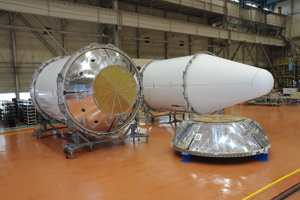Fairing for H-IIA Launch Vehicle No. 21 Delivered
Apr. 02, 2012

Tokyo, April 2, 2012—Kawasaki Heavy Industries, Ltd. announced today that it has shipped a payload fairing (PLF*1) for the H-IIA Launch Vehicle No. 21 to the Tanegashima Space Center. After design and parts manufacturing at Kawasaki's Gifu Works, the PLF was finally assembled and shipped from the Harima Works. The PLF will be delivered to Mitsubishi Heavy Industries, Ltd. and then be incorporated into the H-IIA Launch Vehicle No. 21 in preparation for the upcoming launch scheduled for May 2012.
Measuring 16 m in length and 4.1 m in diameter, the dual-type 4/4D PLF is capable of carrying two satellites at the same time. In the upcoming launch, it will carry the Global Change Observation Mission 1st - Water (SHIZUKU)*2 of the Japan Aerospace Exploration Agency (JAXA) and the Korea Multi-purpose Satellite-3 (KOMPSAT-3)*3 of the Korea Aerospace Research Institute (KARI).
Since delivering the first PLF for the H-II launch vehicle in 1993, Kawasaki has supplied PLFs for a total of seven H-II launch vehicles. Kawasaki has also developed and manufactured a variety of PLFs for a total of 20 H-IIA launch vehicles, including four-meter single (4S), four-meter dual (4/4D), and five-meter single (5S) fairings.
The PLFs for the H-IIA launch vehicle are designed to meet a broad range of payload specifications such as the launch of large satellites as well as the simultaneous launch of two satellites. Kawasaki is playing a vital role in today’s satellite launch industry via the development and production of cutting-edge PLFs.
Overview of PLF for H-IIA Launch Vehicle No. 21
|
Type: |
4-m dual fairing (4/4D) |
|
Length: |
16 m |
|
Diameter: |
Approximately 4.1 m |
|
Payload: |
1 satellite of up to approximately 8.2 m in length, 3.7 m in diameter 1 satellite of up to approximately 5.3 m in length, 3.7 m in diameter |
*1. A payload fairing is an enclosure installed at the tip of a launch vehicle that protects the satellite from aerodynamic heating, acoustic noise and vibration during liftoff. After the launch vehicle leaves the earth's atmosphere, the fairing splits in two and is jettisoned, allowing the satellite to separate from the launch vehicle.
*2. SHIZUKU (GCOM-W1) will be launched as part of a project to observe the long-term changes in the global environment from outer space. It will be used to observe precipitation, water vapor, sea surface wind speed and sea surface temperature.
*3. KOMPSAT-3, a successor to KOMPSAT-1 and -2, features an optical instrument with enhanced resolution capability. Following the sun-synchronous orbit, it will perform various environmental observations and provide high-resolution image data needed for geographical analysis.





